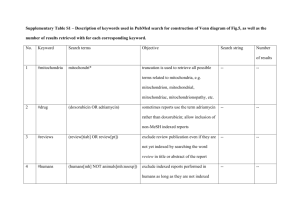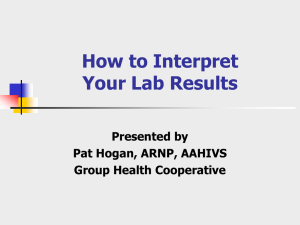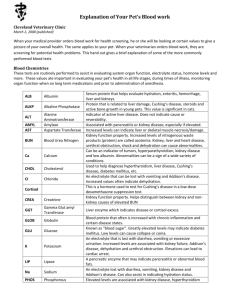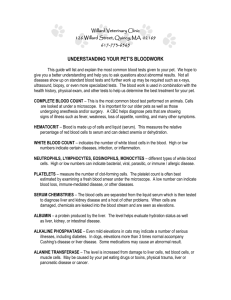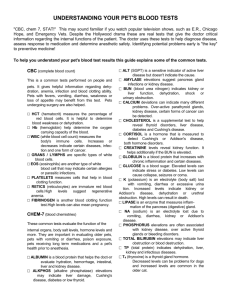TYPES OF COMMON DIAGNOSTIC TESTS The UC needs to be
advertisement
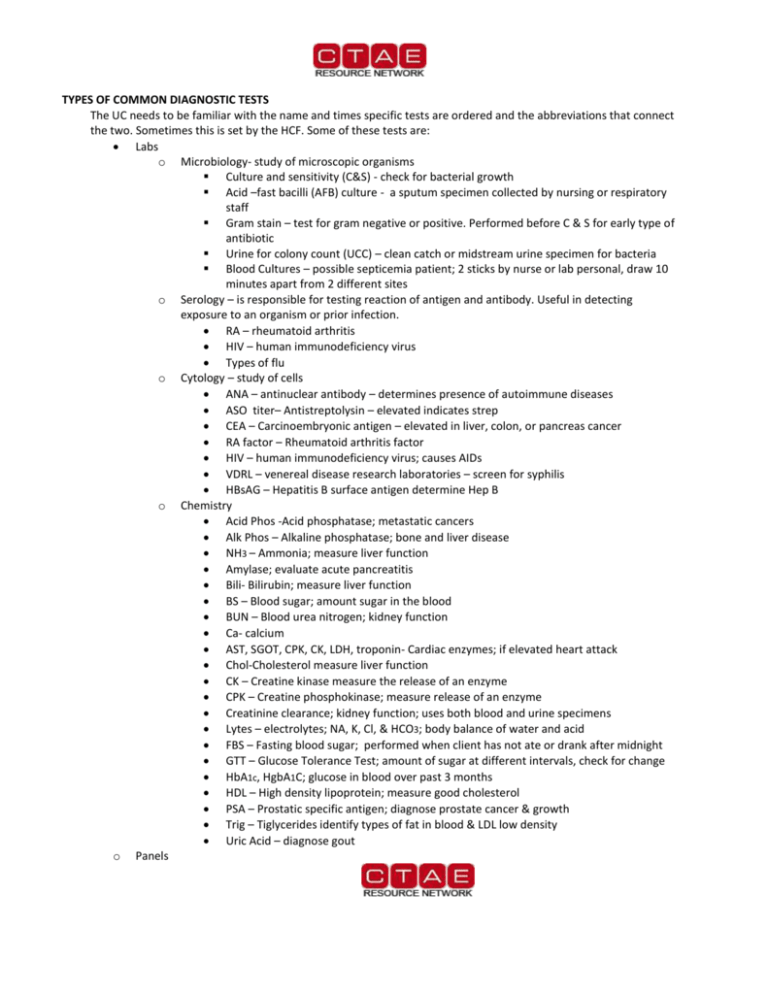
TYPES OF COMMON DIAGNOSTIC TESTS The UC needs to be familiar with the name and times specific tests are ordered and the abbreviations that connect the two. Sometimes this is set by the HCF. Some of these tests are: Labs o Microbiology- study of microscopic organisms Culture and sensitivity (C&S) - check for bacterial growth Acid –fast bacilli (AFB) culture - a sputum specimen collected by nursing or respiratory staff Gram stain – test for gram negative or positive. Performed before C & S for early type of antibiotic Urine for colony count (UCC) – clean catch or midstream urine specimen for bacteria Blood Cultures – possible septicemia patient; 2 sticks by nurse or lab personal, draw 10 minutes apart from 2 different sites o Serology – is responsible for testing reaction of antigen and antibody. Useful in detecting exposure to an organism or prior infection. RA – rheumatoid arthritis HIV – human immunodeficiency virus Types of flu o Cytology – study of cells ANA – antinuclear antibody – determines presence of autoimmune diseases ASO titer– Antistreptolysin – elevated indicates strep CEA – Carcinoembryonic antigen – elevated in liver, colon, or pancreas cancer RA factor – Rheumatoid arthritis factor HIV – human immunodeficiency virus; causes AIDs VDRL – venereal disease research laboratories – screen for syphilis HBsAG – Hepatitis B surface antigen determine Hep B o Chemistry Acid Phos -Acid phosphatase; metastatic cancers Alk Phos – Alkaline phosphatase; bone and liver disease NH3 – Ammonia; measure liver function Amylase; evaluate acute pancreatitis Bili- Bilirubin; measure liver function BS – Blood sugar; amount sugar in the blood BUN – Blood urea nitrogen; kidney function Ca- calcium AST, SGOT, CPK, CK, LDH, troponin- Cardiac enzymes; if elevated heart attack Chol-Cholesterol measure liver function CK – Creatine kinase measure the release of an enzyme CPK – Creatine phosphokinase; measure release of an enzyme Creatinine clearance; kidney function; uses both blood and urine specimens Lytes – electrolytes; NA, K, Cl, & HCO3; body balance of water and acid FBS – Fasting blood sugar; performed when client has not ate or drank after midnight GTT – Glucose Tolerance Test; amount of sugar at different intervals, check for change HbA1c, HgbA1C; glucose in blood over past 3 months HDL – High density lipoprotein; measure good cholesterol PSA – Prostatic specific antigen; diagnose prostate cancer & growth Trig – Tiglycerides identify types of fat in blood & LDL low density Uric Acid – diagnose gout o Panels o o BMP – Basic metabolic; o Lytes – Electrolytes o CMP – comprehensive metabolic o RFP – renal or kidney profile Common Hematology Test o Hct – Hematocrit; loss of blood o Hgb – Hemoglobin: iron in blood; anemia o WBC – White blood cells; infections o RBC – Red Blood Cells; increase hypoxia, low anemia o Diff – Differential; five types of WBC o CBC – Complete Blood Count ( Hgb, Hct, WBC, RBC, Diff Other Diagnostic Test, non Lab o Electrocardiogram (EKG) o Electroencephalogram (EEG) o Echocardiogram (Echo) o Endoscopic Retrograde Cholangiopancreatography (ERCP) o Barium Enema (BE) o Computed Axial Tomography (CAT) o Chest x-ray (CXR) o Upper gastrointestinal series (UGI) o Kidney, Ureters, Bladder (KUB) o Intravenous Pyelogram (IVP) o Ultrasounds Abdomen, liver, pancreas , & uterus o Scans – nuclear medicine Brain, bone, live/spleen, lung, & thyroid Have students develop a graphic organizer to separate which diagnostic test goes with which department of services. http://www.schoollink.org/twin/Creating%20Graphic%20Organizers%20Using%20Microsoft%20Word.pdf This is a link that provides instructions how to create a graphic organizer using Microsoft word. http://eduscapes.com/tap/topic73.htm This site provides a wealth of information on using and creating graphic organizers. http://www.nlm.nih.gov/medlineplus/diagnostictests.html Resource for diagnostic testing
